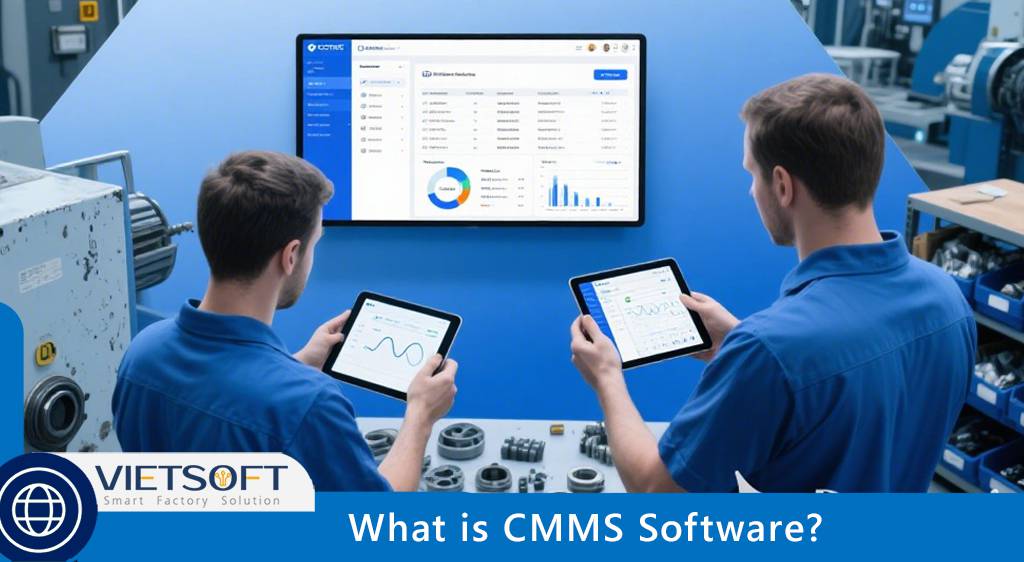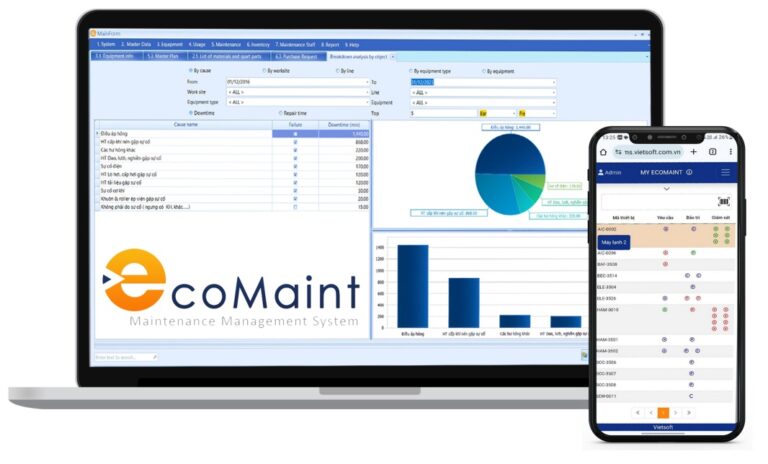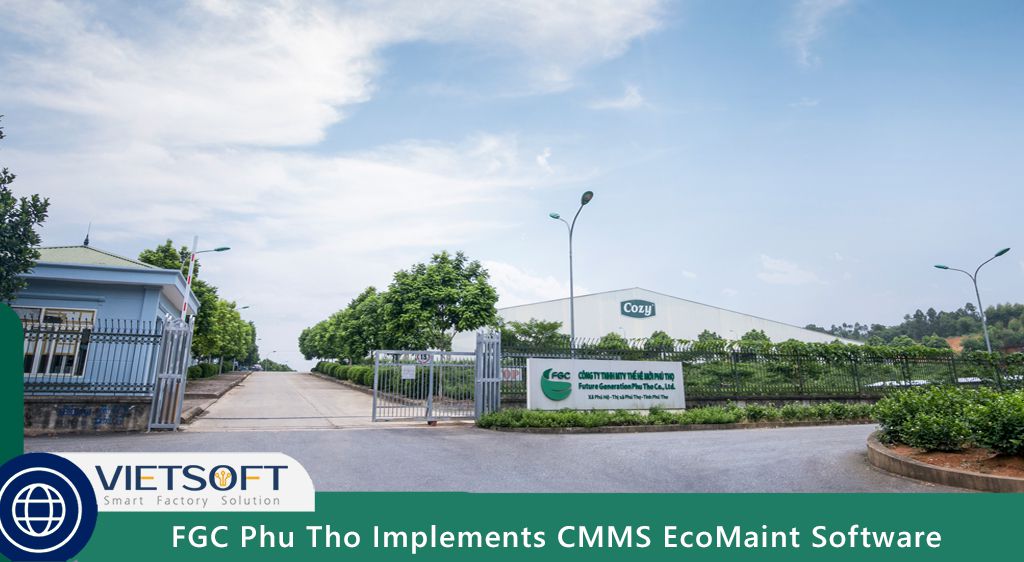I. Introduction to CMMS Software
A Computerized Maintenance Management System (CMMS) is a software platform designed to simplify and optimize maintenance operations by centralizing asset management, work order tracking, inventory control, and reporting. It serves as a digital command center for maintenance teams, enabling them to plan, monitor, and execute tasks efficiently while minimizing equipment downtime and maintenance costs.
The keyword “What is CMMS software?” often arises when businesses seek ways to enhance their maintenance strategies. In essence, CMMS software replaces outdated, manual systems like spreadsheets and paper records, offering a centralized, real-time solution to manage critical maintenance tasks. Whether you’re in manufacturing, healthcare, or facilities management, CMMS software empowers organizations to achieve operational efficiency and asset reliability.
For example, CMMS EcoMaint, a leading solution in Vietnam, helps businesses streamline maintenance workflows with intuitive features tailored to modern industrial needs. Curious about how it works? Explore CMMS EcoMaint to see how it can transform your operations.
II. The Core Definition of CMMS Software
1. What Does CMMS Stand For?
CMMS stands for Computerized Maintenance Management System. It’s a software tool that automates and organizes maintenance tasks, including work order management, preventive maintenance scheduling, asset tracking, and inventory management. By centralizing data, CMMS software provides maintenance teams with a single source of truth, enabling data-driven decisions to improve uptime and reduce costs.
2. How Does CMMS Software Work?
At its core, CMMS software functions as a centralized database that stores and organizes maintenance-related information, such as:
Work Orders: Create, assign, and track work orders for repairs or maintenance tasks.
Asset Information: Monitor asset health, maintenance history, and performance metrics.
Inventory Data: Manage spare parts, track stock levels, and automate reordering.
Scheduling: Automate preventive maintenance schedules based on time, usage, or condition triggers.
Reporting: Generate real-time reports and dashboards to analyze key performance indicators (KPIs) like Mean Time to Repair (MTTR) or Overall Equipment Effectiveness (OEE).
For instance, a technician using CMMS software can access a mobile app to view a work order, check an asset’s maintenance history, and update the task status in real time. This eliminates the need for manual paperwork and ensures seamless communication across teams.
III. Why CMMS Software is Essential for Modern Maintenance
1. The Evolution of Maintenance Management
Historically, maintenance teams relied on manual methods like paper logs or Excel spreadsheets to track tasks. These approaches were prone to errors, lacked real-time visibility, and made it difficult to scale operations. The rise of Industry 4.0, IoT (Internet of Things), and cloud computing has transformed maintenance into a data-driven discipline, with CMMS software at its core.
Modern CMMS solutions integrate with IoT sensors, ERP systems, and AI-driven analytics to provide predictive maintenance capabilities, enabling businesses to anticipate equipment failures before they occur. This shift from reactive to proactive maintenance is a game-changer for industries like manufacturing, logistics, and healthcare.
2. Who Uses CMMS Software?
CMMS software is used by a wide range of professionals, including:
Maintenance Managers: To schedule tasks, prioritize work orders, and monitor team performance.
Technicians: To access work orders, update task statuses, and retrieve asset information on the go.
Facility Managers: To oversee building systems like HVAC, plumbing, and electrical infrastructure.
Inventory Managers: To track spare parts and ensure availability for repairs.
Reliability Engineers: To analyze asset performance and implement predictive maintenance strategies.
Executives: To gain insights into maintenance costs and operational efficiency through reports.
Industries such as manufacturing, healthcare, education, logistics, and utilities benefit significantly from CMMS software due to their reliance on critical assets.
IV. Key Features of CMMS Software
A robust CMMS solution offers a range of features to streamline maintenance operations. Here are the core functionalities to look for:
1. Work Order Management
CMMS software simplifies the creation, assignment, and tracking of work orders. For example, a maintenance manager can assign a repair task to a technician, who receives a notification with detailed instructions, checklists, and asset history. This reduces response times and ensures tasks are completed efficiently.
2. Preventive Maintenance Scheduling
Preventive maintenance (PM) is critical for extending asset lifespan and avoiding unexpected breakdowns. CMMS software automates PM schedules based on time (e.g., every 6 months), usage (e.g., every 1,000 operating hours), or condition-based triggers (e.g., vibration levels exceeding a threshold). For instance, CMMS EcoMaint allows users to set up recurring PM tasks with drag-and-drop calendars, ensuring timely maintenance.
3. Asset Management
CMMS software provides a centralized repository for asset data, including maintenance history, warranty details, and performance metrics. Technicians can scan QR codes or barcodes to access real-time asset information, making it easier to troubleshoot issues and make repair-or-replace decisions.
4. Inventory and Spare Parts Management
Effective inventory management ensures that spare parts are available when needed, minimizing downtime. CMMS software tracks stock levels, automates reordering, and provides insights into part usage trends. For multi-site operations, it enables spare parts sharing across facilities, reducing costs.
5. Reporting and Analytics
Customizable dashboards and reports allow maintenance teams to monitor KPIs such as:
Mean Time Between Failures (MTBF): Measures the average time between equipment failures.
Mean Time to Repair (MTTR): Tracks the average time to complete repairs.
Overall Equipment Effectiveness (OEE): Evaluates equipment productivity and efficiency.
These metrics help identify bottlenecks, optimize workflows, and justify maintenance investments.
6. Mobile Accessibility
A mobile-friendly CMMS app allows technicians to access work orders, update tasks, and scan assets from anywhere. Offline functionality ensures seamless operation in remote or low-connectivity environments, with data syncing once connectivity is restored.
7. Regulatory Compliance and Audit Trails
CMMS software simplifies compliance with regulations like OSHA, ISO, or FDA by maintaining digital records of maintenance activities, safety inspections, and audit trails. Automated logs and electronic signatures streamline audit preparation, reducing compliance risks.
8. Integration Capabilities
Modern CMMS solutions integrate with ERP systems (e.g., SAP), IoT devices, and condition-monitoring tools to provide a holistic view of operations. For example, integrating CMMS with IoT sensors enables predictive maintenance by analyzing real-time data like temperature or vibration.
V. Benefits of Using CMMS Software
Implementing CMMS software offers numerous advantages for businesses. Below are the top benefits, explained with practical examples:
1. Reduced Downtime
By enabling preventive and predictive maintenance, CMMS software helps identify potential issues before they lead to equipment failures. For example, a manufacturing plant using CMMS can schedule regular maintenance for a critical conveyor belt, reducing unplanned downtime by up to 27%, according to industry studies.
2. Cost Savings
CMMS software minimizes emergency repairs and optimizes inventory management, reducing maintenance costs. A recent IDC report noted that CMMS users achieve a 10% reduction in production-related costs by streamlining workflows and avoiding overstocking parts.
3. Improved Operational Efficiency
Automation of repetitive tasks like scheduling and inventory reordering frees up technicians to focus on high-value activities. For instance, CMMS EcoMaint automates work order assignments based on technician availability, boosting efficiency by 44%.
4. Enhanced Asset Reliability
With detailed asset histories and real-time monitoring, CMMS software helps maintenance teams make informed decisions about repairs, upgrades, or replacements. This extends asset lifespan and improves reliability.
5. Better Team Collaboration
CMMS software provides a centralized platform for communication, with real-time notifications and updates. Technicians in the field can share photos or videos of issues, while managers monitor progress from the office, fostering seamless collaboration.
6. Simplified Compliance
Digital records and automated audit logs make it easier to meet regulatory requirements. For example, a pharmaceutical company using CMMS can generate compliance reports for FDA audits in minutes, ensuring adherence to 21 CFR Part 11 standards.
7. Data-Driven Decision Making
Customizable reports and dashboards provide insights into maintenance performance, enabling managers to allocate resources effectively and prioritize critical tasks. For example, analyzing MTBF data can help identify underperforming assets and guide capital investment decisions.
VI. CMMS vs. EAM vs. ERP: Understanding the Differences
While CMMS, Enterprise Asset Management (EAM), and Enterprise Resource Planning (ERP) systems share some similarities, they serve distinct purposes:
CMMS: Focuses on maintenance operations, including work orders, preventive maintenance, and asset tracking. It’s ideal for maintenance teams looking to optimize daily tasks.
EAM: Encompasses the entire asset lifecycle, from procurement to disposal, including financial and regulatory aspects. EAM systems often include CMMS functionalities.
ERP: Manages broader business functions like finance, HR, and supply chain. While ERP systems may include basic maintenance modules, they lack the specialized features of CMMS.
For example, a manufacturing plant might use CMMS EcoMaint for maintenance tasks, integrate it with an ERP for procurement, and leverage EAM for long-term asset planning. Learn how CMMS EcoMaint integrates with your systems.
VII. Industries That Benefit from CMMS Software
CMMS software is versatile and applicable across various industries, including:
Manufacturing: Automates maintenance for production equipment, reducing downtime and ensuring quality.
Healthcare: Manages medical equipment and facility systems to comply with strict regulations.
Logistics and Fleet Management: Tracks vehicle maintenance to prevent breakdowns and optimize fleet performance.
Facilities Management: Oversees building systems like HVAC and plumbing in commercial properties.
Utilities: Maintains critical infrastructure like power plants and water treatment facilities.
Education: Ensures campus facilities are safe and operational for students and staff.
For instance, a logistics company using CMMS can schedule preventive maintenance for delivery trucks, reducing repair costs and improving delivery schedules.
VIII. How to Choose the Best CMMS Software
Selecting the right CMMS software requires careful consideration of your organization’s needs. Here are key factors to evaluate:
1. Ease of Use
An intuitive interface ensures quick adoption by technicians and managers. Look for a CMMS with customizable dashboards and a user-friendly mobile app.
2. Scalability
Choose a solution that grows with your business, supporting multi-site operations and additional users as needed.
3. Integration Capabilities
Ensure the CMMS integrates with existing systems like ERP, IoT, or SCADA to maximize data visibility.
4. Vendor Support
A reliable vendor provides comprehensive training, implementation support, and ongoing customer service. For example, CMMS EcoMaint offers dedicated support to ensure successful deployment.
5. Cloud-Based vs. On-Premise
Cloud-based CMMS solutions, like CMMS EcoMaint, offer greater flexibility, lower upfront costs, and remote accessibility compared to on-premise systems, which require significant IT infrastructure.
6. Cost and ROI
Evaluate the total cost of ownership, including subscription fees, implementation, and training. Use ROI calculators to estimate savings from reduced downtime and improved efficiency.
IX. Calculating the ROI of CMMS Software
Investing in CMMS software can yield significant returns by reducing maintenance costs and improving uptime. To calculate ROI, consider:
Cost Savings: Reduced emergency repairs, lower inventory costs, and optimized labor allocation.
Revenue Gains: Increased uptime and productivity, leading to higher output.
Intangible Benefits: Improved team morale, better compliance, and enhanced decision-making.
For example, a facility implementing CMMS might save $50,000 annually by reducing downtime by 20% and cutting inventory waste by 15%. Tools like the CMMS EcoMaint ROI Calculator can help quantify these savings. Try it now.
X. Real-World Example: CMMS EcoMaint in Action
Imagine a manufacturing plant in Vietnam struggling with frequent equipment breakdowns and high maintenance costs. By implementing CMMS EcoMaint, the plant automates preventive maintenance schedules, reducing downtime by 25%. Technicians use the mobile app to access work orders and update tasks in real time, while managers monitor KPIs through customizable dashboards. The result? A 15% reduction in maintenance costs and a 30% improvement in asset reliability within the first year.
Ready to see how CMMS EcoMaint can transform your maintenance operations? Request a demo today and discover its powerful features tailored to your industry.
XI. FAQs About CMMS Software
1. What is the best CMMS software?
The best CMMS software depends on your organization’s needs, but it should offer configurability, mobile accessibility, and robust support. CMMS EcoMaint is a top choice for its ease of use and industry-specific features.
2. How much does CMMS software cost?
Costs vary based on features, users, and deployment type (cloud-based or on-premise). Cloud-based solutions typically use a subscription model, with pricing based on user count and functionality. For detailed pricing, visit CMMS EcoMaint.
3. Can CMMS software integrate with other systems?
Yes, modern CMMS solutions integrate with ERP, IoT, and condition-monitoring tools to enhance data visibility and streamline operations.
4. Who should use CMMS software?
Any organization with physical assets, from manufacturing plants to healthcare facilities, can benefit from CMMS software to improve maintenance efficiency and asset reliability.
XII. Conclusion
Understanding what CMMS software is and its role in modern maintenance is crucial for businesses aiming to stay competitive. By centralizing maintenance data, automating tasks, and enabling data-driven decisions, CMMS software transforms how organizations manage assets and operations. From reducing downtime to ensuring compliance, the benefits are clear and measurable.
CMMS EcoMaint stands out as a powerful, user-friendly solution designed to meet the unique needs of businesses in Vietnam and beyond. With features like mobile accessibility, predictive maintenance, and seamless integrations, it’s the ideal choice for achieving maintenance excellence. Ready to take the next step? Explore CMMS EcoMaint and start your journey toward smarter maintenance today.





